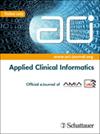Standardization of Emergency Department Clinical Note Templates: A Retrospective Analysis Across an Integrated Health System.
IF 2.1
2区 医学
Q4 MEDICAL INFORMATICS
引用次数: 0
Abstract
Background / Objective: Clinical documentation is essential for conveying medical decision-making, communication between providers and patients, and capturing quality, billing, and regulatory measures during emergency department (ED) visits. Growing evidence suggests the benefits of note template standardization, however, variations in documentation practices are common. The primary objective of this study is to measure the utilization and coding performance of a standardized ED note template implemented across a nine-hospital health system. METHODS This was a retrospective study before and after the implementation of a standardized ED note template. A multi-disciplinary group consensus was built around standardized note elements, provider note workflows within the electronic health record (EHR), and how to incorporate newly required medical decision-making elements. The primary outcomes measured included the proportion of ED visits using standardized note templates, and the distribution of billing codes in the six months before and after implementation. RESULTS In the pre-implementation period, a total of six legacy ED note templates were being used across nine emergency departments, with the most used template accounting for approximately 36% of ED visits. Marked variations in documentation elements were noted across six legacy templates. After the implementation, 82% of ED visits system-wide used a single standardized note template. Following implementation, we observed a 1% increase in the proportion of ED visits coded as highest acuity and an unchanged proportion coded as second highest acuity. CONCLUSIONS We observed a greater than two-fold increase in the use of a standardized ED note template across a 9-hospital health system in anticipation of the new 2023 coding guidelines. The development and utilization of a standardized note template format relied heavily on multi-disciplinary stakeholder engagement to inform design that worked for varied documentation practices within the EHR. After the implementation of a standardized note template, we observed better-than-anticipated coding performance.急诊科临床笔记模板的标准化:一个综合医疗系统的回顾性分析。
背景/目的:在急诊科(ED)就诊过程中,临床记录对于传达医疗决策、医疗服务提供者与患者之间的沟通以及掌握质量、账单和监管措施至关重要。越来越多的证据表明,笔记模板标准化有其益处,然而,记录实践中的差异却很常见。本研究的主要目的是衡量在九家医院的医疗系统中实施标准化急诊科病历模板的利用率和编码性能。方法这是一项在实施标准化急诊科病历模板前后进行的回顾性研究。多学科小组围绕标准化病历要素、电子病历(EHR)中的医疗服务提供者病历工作流程以及如何纳入新要求的医疗决策要素达成了共识。测量的主要结果包括使用标准化病历模板的急诊就诊比例,以及实施前后 6 个月的计费代码分布情况。结果 在实施前,9 个急诊科共使用了 6 种传统的急诊病历模板,其中使用最多的模板约占急诊就诊的 36%。六种传统模板的记录要素存在明显差异。实施后,全系统 82% 的急诊室出诊使用了单一的标准化记录模板。实施后,我们观察到急诊室就诊中被编码为最高危重程度的比例增加了 1%,而被编码为次高危重程度的比例保持不变。结论我们观察到,在一个 9 家医院的医疗系统中,标准化急诊室就诊记录模板的使用率增加了两倍多,以迎接 2023 年的新编码指南。标准化便条模板格式的开发和使用在很大程度上依赖于多学科利益相关者的参与,以便为设计提供信息,使其适用于电子病历中的各种文档实践。实施标准化备注模板后,我们发现编码性能优于预期。
本文章由计算机程序翻译,如有差异,请以英文原文为准。
求助全文
约1分钟内获得全文
求助全文
来源期刊

Applied Clinical Informatics
MEDICAL INFORMATICS-
CiteScore
4.60
自引率
24.10%
发文量
132
期刊介绍:
ACI is the third Schattauer journal dealing with biomedical and health informatics. It perfectly complements our other journals Öffnet internen Link im aktuellen FensterMethods of Information in Medicine and the Öffnet internen Link im aktuellen FensterYearbook of Medical Informatics. The Yearbook of Medical Informatics being the “Milestone” or state-of-the-art journal and Methods of Information in Medicine being the “Science and Research” journal of IMIA, ACI intends to be the “Practical” journal of IMIA.
 求助内容:
求助内容: 应助结果提醒方式:
应助结果提醒方式:


